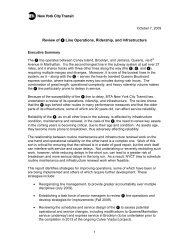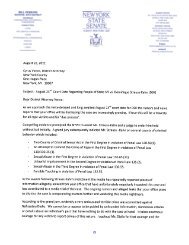Crime Committee Report e.indd - New York State Senate
Crime Committee Report e.indd - New York State Senate
Crime Committee Report e.indd - New York State Senate
You also want an ePaper? Increase the reach of your titles
YUMPU automatically turns print PDFs into web optimized ePapers that Google loves.
VII.<br />
2009-10 Inspection of <strong>State</strong> Prisons<br />
In 2009, DOCS Commissioner Brian Fisher invited the <strong>Senate</strong> Standing <strong>Committee</strong> on<br />
<strong>Crime</strong>, <strong>Crime</strong> Victims and Correction to inspect the new facilities at Marcy <strong>State</strong> Correctional<br />
Facility located in Oneida County. The Commissioner also gave legislators and staff a tour of<br />
Sing Sing Prison located in Westchester County. Soon thereafter, along with Senator Betty Little<br />
and staff we visited Camp Gabriel in Franklin County.<br />
Marcy <strong>State</strong> Correctional Facility is located in Marcy, <strong>New</strong> <strong>York</strong>. The prison is located across<br />
from Central <strong>New</strong> <strong>York</strong> Psychiatric Center and Mid-<strong>State</strong> Correctional Facility. These facilities<br />
have historically housed prisoners with psychiatric ailments.<br />
The Commissioner gave Members and staff a tour of the new 100 bed Residential Mental<br />
Health Unit (RMHU) at the existing S-block site at Marcy Correctional Facility. The Commissioner<br />
explained that doubled celled space was being converted to 100 single spaced cells to<br />
provide a heightened level of care to seriously mentally ill inmates who have also committed<br />
serious acts of misconduct while incarcerated.<br />
We walked through specially designed facilities for clinical staff offices and program staff. To<br />
a great degree, the architectural design more resembled a clean and modern hospital clinic.<br />
<strong>New</strong> doors were designed to maximize visibility around all areas of the complex. Specialized<br />
“re-start” chairs for use in therapy sessions were designed to provide inmates more freedom of<br />
movement while maintaining safety and security for DOCS and OMH staff. The Commissioner<br />
stated that inmates would be offered four hours per day of structured out-of-cell therapeutic<br />
treatment and programming and that the curriculum and protocols designed by the Office of<br />
Mental Health would soon be regarded as a national model of treatment. We saw conference<br />
rooms where a Joint Central Review <strong>Committee</strong> would be able to “televideo” with the OMH staff<br />
and holistically review the case file of each inmate suffering from serious mental illness.<br />
We were impressed with the sense of excitement accompanying the development of the new<br />
100-bed Residential Mental Health Unit at Marcy. Because of our public hearing regarding the<br />
SHU Exclusion Law we were aware of how sorely needed an alternative to segregated housing<br />
units was for seriously mentally ill inmates. We left Marcy with a greater belief that the SHU<br />
Exclusion Law and Private Settlement Agreement would make profound differences in the<br />
treatment of human beings behind bars.<br />
Commissioner Fisher also walked with us though one of the segregated housing units at Sing<br />
Sing Prison, a maximum security facility located in Ossining, <strong>New</strong> <strong>York</strong>. Sing Sing Correctional<br />
Facility was built in 1826. By 1916 all executions by electric chair were assigned to Sing Sing. In<br />
1927, Ruth Synder was executed for murdering her husband in order to gain insurance money.<br />
A <strong>New</strong> <strong>York</strong> Daily <strong>New</strong>s photographer hid a camera on his ankle, and at the moment the first<br />
jolt of electricity passed through Synder’s body, he snapped the most famous and only picture<br />
ever taken during an execution. This photo is still in demand today. Most notably, Julius and<br />
Ethel Rosenberg, both convicted of espionage were executed at Sing Sing in 1953.<br />
Senator Ruth Hassell-Thompson and Senator Eric Schneiderman met with prisoners who received<br />
college degrees with honors while behind bars. Some were sentenced to life for murder<br />
and some were sentenced to 10 or more years for violent felonies like robbery and burglary. All<br />
of the inmates were polite and communicative. They spoke about the need for more educational<br />
programs for inmates, in particular GED programs for older inmates. They asked the<br />
Members to consider making violent felons eligible for Merit Time. Other men said they were<br />
repeatedly denied parole notwithstanding exemplary conduct while in prison. They pointed<br />
out that most inmates charged with the most serious crimes have the lowest recidivism rates.<br />
They did not complain or deny responsibility for their crimes, but rather rhetorically questioned<br />
the quantum of proof necessary to prove one has paid his debt to society.<br />
Standing <strong>Committee</strong> on <strong>Crime</strong> Victims, <strong>Crime</strong> and Correction | 2009-2010 <strong>Report</strong> 13









![[PDF] Proposed MTA Capital Program - New York State Senate](https://img.yumpu.com/24854139/1/190x245/pdf-proposed-mta-capital-program-new-york-state-senate.jpg?quality=85)






